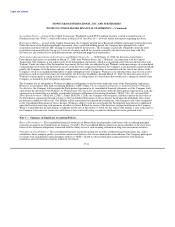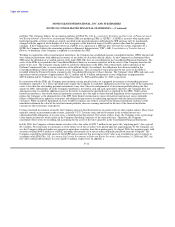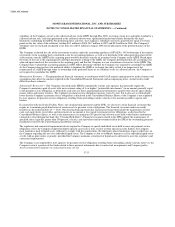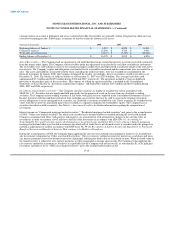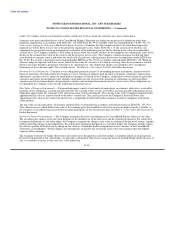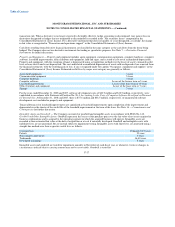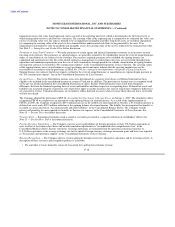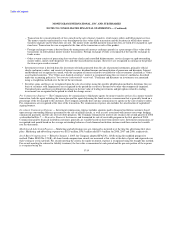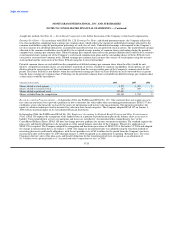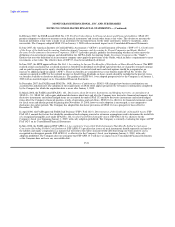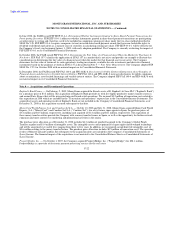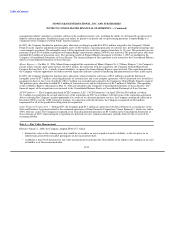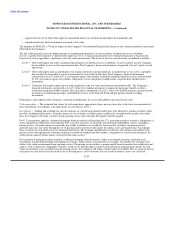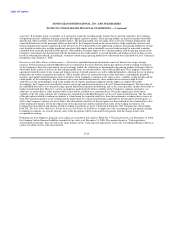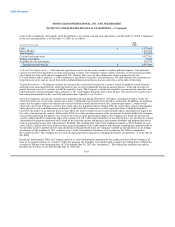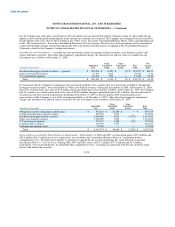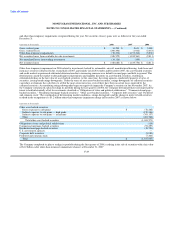MoneyGram 2008 Annual Report Download - page 106
Download and view the complete annual report
Please find page 106 of the 2008 MoneyGram annual report below. You can navigate through the pages in the report by either clicking on the pages listed below, or by using the keyword search tool below to find specific information within the annual report.
Table of Contents
MONEYGRAM INTERNATIONAL, INC. AND SUBSIDIARIES
NOTES TO CONSOLIDATED FINANCIAL STATEMENTS — (Continued)
straight-line method. See Note 14 — Stock-Based Compensation for further discussion of the Company's stock-based compensation.
Earnings Per Share — In accordance with SFAS No. 128, Earnings Per Share, and related pronouncements, the Company utilizes the
two-class method for computing basic earnings per common share, which reflects the amount of undistributed earnings allocated to the
common stockholders using the participation percentage of each class of stock. Undistributed earnings is determined as the Company's
net (loss) income less dividends declared or accumulated on preferred stock less any preferred stock accretion. The undistributed earnings
allocated to the common stockholders are divided by the weighted-average number of common shares outstanding during the period to
compute basic earnings per common share. Diluted earnings per common share reflects the potential dilution that could result if securities
or incremental shares arising out of the Company's stock-based compensation plans and the outstanding shares of Series B Stock were
exercised or converted into common stock. Diluted earnings per common share assumes the exercise of stock options using the treasury
stock method and the conversion of the Series B Stock using the if-converted method.
Potential common shares are excluded from the computation of diluted earnings per common share when the effect would be anti-
dilutive. All potential common shares are anti-dilutive in periods of net loss available to common stockholders. Stock options are anti-
dilutive when the exercise price of these instruments is greater than the average market price of the Company's common stock for the
period. The Series B Stock is anti-dilutive when the incremental earnings per share of Series B Stock on an if-converted basis is greater
than the basic earnings per common share. Following are the potential common shares excluded from diluted earnings per common share
as their effect would be anti-dilutive:
(Amounts in thousands) 2008 2007 2006
Shares related to stock options 3,577 1,495 2
Shares related to restricted stock 127 249 —
Shares related to preferred stock 337,637 — —
Shares excluded from the computation 341,341 1,744 2
Recent Accounting Pronouncements — In September 2006, the FASB issued SFAS No. 157. This statement does not require any new
fair value measurement, but it provides guidance on how to measure fair value under other accounting pronouncements. SFAS 157 also
establishes a fair value hierarchy to classify the source of information used in fair value measurements. The hierarchy prioritizes the
inputs to valuation techniques used to measure fair value into three broad categories. The Company adopted SFAS 157 on January 1,
2008 with no material impact on its Consolidated Financial Statements.
In September 2006, the FASB issued SFAS No. 158, Employers' Accounting for Defined Benefit Pension and Other Postretirement
Plans. SFAS 158 requires the recognition of the funded status of a pension or postretirement plan in the balance sheet as an asset or
liability. Unrecognized prior service cost and gains and losses are recorded to "Accumulated other comprehensive loss" in the
Consolidated Balance Sheets. SFAS 158 does not change previous guidance for income statement recognition. The standard requires the
plan assets and benefit obligations to be measured as of the annual balance sheet date of the Company. Prospective application of
SFAS 158 is required. The Company adopted the recognition and disclosure provisions of SFAS 158 at December 31, 2006 and adopted
the change in measurement date as of January 1, 2008. The change in measurement date was adopted using the transition method of
measuring plan assets and benefit obligations, with the net periodic costs of $0.4 million for the period from the Company's previous
measurement date of November 30, 2007 through January 1, 2008 recognized as an adjustment to opening "Retained loss," net of tax.
Changes in the fair value of the plan assets and benefit obligation for the transition period were recognized as an adjustment of
$1.5 million to the opening balance of "Accumulated other comprehensive loss" in 2008.
F-20



